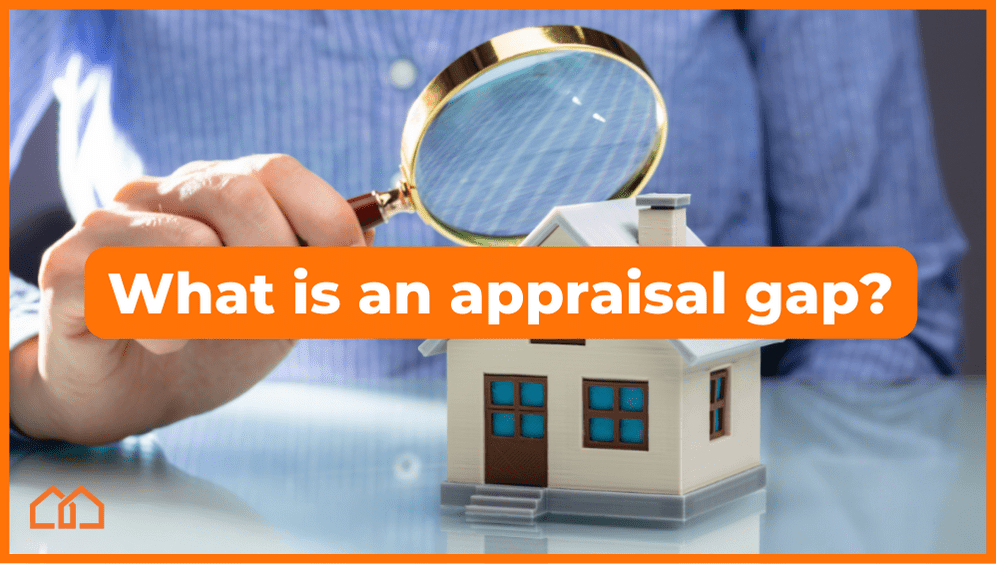What is an appraisal gap?
An appraisal gap is the difference between the offer price and the home’s actual appraised value. It’s common in a market when sellers are forced to over-offer in a competitive market. So, if you offered $365,000 on a home and it appraises for $353,000, you have an appraisal gap of $12,000.
When a buyer makes an offer on a home, the appraisal is a necessary step that happens during the due diligence process. It usually happens after the home inspection, with the appraiser following similar steps to the home inspector in assessing the home’s value. The appraisal considers comparable homes in the neighborhood in combination with the home’s specific value regarding its condition. An old roof, outdated appliances, or other elements in disrepair can bring down the home’s appraised value.
The bank or lender goes by the appraiser’s calculated value of the home, not the real estate agent’s comparative market analysis or any estimates you find on Redfin or Zillow.
When a buyer gets a low appraisal, it means that the home’s assessed value is less than what they are offering. It spells trouble because the bank will only lend what amount the appraiser states is the official value of the property. This is a protective measure for the bank to not lend more than what it could recoup in case the future homeowner fails to pay their mortgage loan.
Who pays the appraisal gap?
When faced with an appraisal gap, the buyer has two choices: Pay the “delta” or the difference upfront at closing or get the seller to lower the price to match the appraisal. Depending on the market, the seller may be more or less inclined to meet the buyer’s expectations for a price reduction. If anything, the seller can knock a few thousand off and meet the buyer in the middle.
When the seller agrees to a price change, your realtor can amend the final price in the purchase agreement during due diligence. An experienced realtor should have an appraisal contingency in place so that their buyer can back out without consequences and get their earnest money deposit back.
It’s important to look before you leap- buyers should always ask their realtor if there is an appraisal gap coverage clause in the contract. This enables them to get a guaranteed coverage amount from the seller-or walk away- if the numbers don’t add up.
Are appraisal gaps more common in buyer or seller’s markets?
In a seller’s market, an appraisal gap is one of the biggest hurdles homebuyers face. In 2022, we had a serious seller’s market. Low inventory and high demand drove up home prices. According to NAR in their Realtors Confidence Index, an estimated 54% of homes were getting offers over their listing price. This compelled buyers to hike their offer price to get noticed and to accept the drudgery of paying the delta.
Conversely, in 2023, the housing market looks quite different. Doubled interest rates have decreased home purchase demand, decreasing the occurrence of bidding wars. Seller concessions are also back on the table, with sellers more inclined to offer perks like paying for closing costs to secure a deal. There is far less chance of a buyer over-offering in these market conditions.
Who is responsible for the appraisal gap?
Either the buyer or seller -or both parties- are responsible for paying the appraisal gap. In a hot seller’s market, the responsibility typically falls on the buyer. However, sellers in a time crunch can match the price if they are on a strict moving timeline, even in a seller’s market.
If the appraisal price is lower than the contract price, your mortgage lender will not be covering the difference when they give you your loan. This appraisal gap will also not be lumped in with your down payment. In other words, if a house is $510,000 and the appraised value is $500,000 with a gap of $10,000, you will have to pay that $10K plus your down payment.
How does a lender’s appraisal work for mortgages?
After a home gets under contract, it undergoes various inspections. During this process, a licensed appraiser comes to the home and inspects it, then creates a report that explains the home’s appraised value. (An appraisal can also happen when you want to refinance, but that’s a story for another day.)
As a buyer, the appraisal process is required by your lender in order to finalize the loan amount they give you. The lender usually won’t approve a mortgage on a loan that is higher than the home’s appraised value, because that’s a bigger risk for them.
An appraiser will evaluate the home’s value by looking at various factors such as zoning, lot size, location, square footage, general condition of the home, etc. An appraiser will also compare the home to other properties that have sold in the area.
So what happens when the appraisal comes in low but you offered high? You have several options:
- Pay the delta (aka difference).
- Get your real estate agent to negotiate a price drop.
- Get your real estate agent to convince the seller to meet you in the middle.
- Order a new appraisal and hope for better numbers.
- Back out if you can’t pay the difference (you’re protected through the appraisal clause).
Once you complete an appraisal for a mortgage, you should receive the results in the appraiser’s report. What comes next depends on the number and the details of your contract.
How Appraisal Gaps Work: A Step-By-Step Process
Step 1: Decide if you want to back out or lean in.
If you’re financing your home through a lender, you should have a home appraisal contingency clause in your purchase contract. It’s a contingency that allows you to cancel the contract without losing your earnest money, pending the results of the appraisal. If the appraisal comes in at your purchase price or higher, you may decide to proceed without issue. If the appraisal comes in lower, you have some decisions to make. You can back out without any penalty, or you can press your luck with negotiations.
Step 2: Time for your realtor to shine.
If you really want the house, it’s time for your real estate agent to step in and negotiate. They will do their best to convince the other agent to lower the sales price to the appraisal or to meet the buyer in the middle to decrease the appraisal gap. Here are the possible outcomes:
- In hot real estate markets, sellers know that they can just say “no” because another buyer is waiting in line. This means that the buyer must accept the higher price or back out. You may take your earnest money deposit and start over.
- Sometimes a seller will agree to lower the price, even in a hot market, because they don’t want to delay the moving timeline. This makes it easier for the deal to proceed. When sellers are more motivated to sell their home, they may step up and cover the difference in the gap.
Step 3: Order a new appraisal.
Determining the property value of a house treads a fine line between facts and perspective. In many ways, it is like a comparative market analysis. The more experienced the appraiser, the more accurate the outcome will be. This is why no two appraisals are exactly the same. If you feel like the appraiser missed something and came up with an inaccurate appraised value of a home, then you should schedule a second appraisal.
Did the appraiser know the area well? Did the appraiser use the right comps? Was the appraiser inexperienced? Was the appraiser looking at comparable sales from the current market or from too long ago? Did they stay in the neighborhood or go into another area that has a lower fair market value?
These are just some of the questions you can think about to examine why the appraisal came in lower than the contract price.
Step 4: Decide based on the seller’s choice or the second appraisal.
Let’s say that your second appraisal still came in pretty low. What now? The next best thing is to figure out your finances and negotiate with your sellers and hopefully find a happy solution for both sides. Or, alternatively, you can walk away and work on finding another house.
If you are able, you can shift your down payment and go for a lower percentage. You can also pay the difference in cash. If you have enough cash, you can also pay down your mortgage rates and get excellent monthly borrower payments.
How can you negotiate with sellers?
The best thing you can do in this situation is to remain flexible. Can you offer your sellers to stay in the home longer or allow them to move out quicker? Can you take on certain repairs the sellers originally planned to make before you moved in?
Perhaps they had a bunch of furniture they wanted to get rid of during the move, can you take those off their hands for them? Think about all the “benefits” you can offer your sellers and use those when you’re negotiating. Don’t be afraid to negotiate on the original contract price either – do they have any wiggle room on their purchase price?
Can you offer to cover the appraisal gap?
In a very tight seller’s market, it’s common for buyers to bid above asking price as a way to entice sellers to choose the offer. Of course, if your contract fails at the point of appraisal, you’ve wasted time and money in the effort.
Instead, it’s worth considering something like appraisal gap coverage. Also called an appraisal guarantee, appraisal gap coverage provides a degree of assurance to the seller that you will cover the difference between the contract price and the appraisal, if it comes in lower.
In most cases, the guarantee has a defined limit. You might say that you are willing to pay up to a certain amount, such as $10,000. If the gap is larger than the specified amount, there’s no guarantee that the seller will renegotiate the contract. However, if you have the cash to spare, this coverage can be an extra tool in your box to keep the contract moving forward.
Ready to start looking for the perfect home? Let’s talk.
Serena Yan worked as a digital content producer at Marketplace Homes in 2021 and contributed many insightful pieces of content to the MPH blog. During her time at Marketplace Homes, she researched the real estate market, analyzed trends to streamline Marketplace Home’s marketing strategy, and found ways to best engage target audiences. Through writing blogs with topics ranging from market trends to home living, she contributed a lot to the early stages of this blog. Thank you, Serena!


